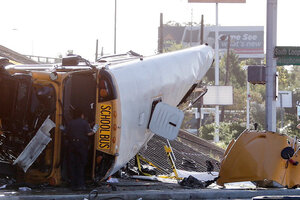Two students killed in Houston crash: How safe are school buses?
Two students and the driver were also seriously injured in the crash. The driver had a clean driving record and the bus had passed a maintenance inspection in June.

An emergency personnel looks inside a school bus after the bus went off a Houston freeway and rolled in southeast Houston on Tuesday. The Houston Independent School District says a girl died in Tuesday morning’s accident. Emergency responders say the student was dead at the scene. Officials are trying to determine what caused the crash. A district spokeswoman says it appears the bus went off an overpass.
Cody Duty/Houston Chronicle/AP
Two students were killed when a school bush overturned and crashed in Houston on Tuesday morning. Two other students and the driver were seriously injured in the crash.
The bus was bound for Furr High School and four students, two males and two females, were on board at the time of the crash, according to a statement from officials in the Houston Independent School District.
“We are deeply saddened by this tragedy and the loss of one of our students,” said Terry Grier, superintendent of the school district. “I ask all of the HISD community to join me in praying for all of those involved.”
The driver of the bus has a clean driving record and has been with the district for about three years, HSID officials said. The bus itself underwent a maintenance inspection in June,
The National Highway Traffic Safety Administration (NHTSA) tout school buses as the safest method for transporting students to and from school. In fact, the NHTSA says that American students are nearly eight times safer riding in a school bus than with their own parents and guardians in cars.
According to NHTSA data, “from 2004 to 2013 there were 327 school-age children who died in school-transportation-related crashes; 54 were occupants of school transportation vehicles, 147 were occupants of other vehicles, 116 were pedestrians, 9 were pedal cyclists, and 1 was other nonoccupant.”
Over the years, school bus accidents have raised concern over the safety of school buses with some advocating that school buses should be retrofitted with seat belts.
However NHTSA explains that there there’s little reason to require seat belt installation,
Large school buses are heavier and distribute crash forces differently than do passenger cars and light trucks. Because of these differences, the crash forces experienced by occupants of buses are much less than that experienced by occupants of passenger cars, light trucks or vans. NHTSA decided that the best way to provide crash protection to passengers of large school buses is through a concept called “compartmentalization.” This requires that the interior of large buses provide occupant protection such that children are protected without the need to buckle-up.
Carl Azuz pointed out in a 2012 piece for CNN, “like many school-related issues, the federal government allows states and districts to set the rules when it comes to seat belts on school buses. One downside is cost: Buses with built-in seat belts are more expensive. And at a time when school systems are looking for ways to cut costs – in some cases, cutting some school bus routes themselves – it’s not likely you’ll see an uptick in the number of buses with seat belts.”

